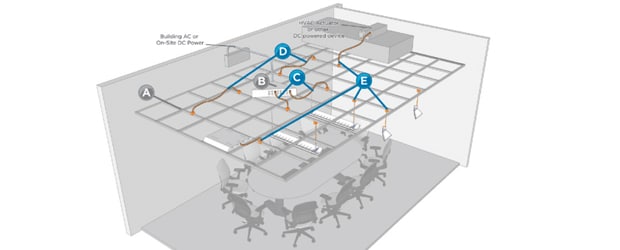
Building Energy Efficiency
How connecting DC power from the grid to the desktop will deliver cost savings to building owners
Contributed By
Leigh Marolf
Industry Marketing Manager, Intelligent Buildings
Energy Savings
AC to DC Conversion
Today we live in an AC (alternating current) world where commercial buildings consume up to 50% of the electricity produced and distributed by public utilities. Electricity demands within these buildings are increasingly DC (direct current) based as the adoption of solid state lighting and DC-powered data centers grows. By eliminating the AC to DC conversion, there can be significant reduction in the complexity of equipment design and energy savings of 15%.
The Connectivity Challenge
Industry Standards
So how do you safely distribute DC power to these new lighting systems and data centers? One open industry association, the EMerge Alliance, is leading the adoption of safe low-voltage DC power distribution in commercial buildings. This alliance is a collaboration of industry leaders, including Armstrong World Industries, Royal Philips Electronics and TE Connectivity. As part
of this alliance, our mission is to develop DC voltage standards for 24Vdc and 380Vdc, and to provide the plug-and-play connectivity for the 24Vdc standard.

The DC Power Innovation
EMerge Alliance
The engineers at TE developed a system of connectors and cable assemblies that allowed the safe transfer of power from a DC-powered ceiling grid to lighting fixtures and other electrical devices used in the system. All interconnects meet the requirements of the EMerge Alliance standard.
EMerge is a trademark of the EMerge Alliance

Building Energy Efficiency
How connecting DC power from the grid to the desktop will deliver cost savings to building owners
Contributed By
Leigh Marolf
Industry Marketing Manager, Intelligent Buildings
Energy Savings
AC to DC Conversion
Today we live in an AC (alternating current) world where commercial buildings consume up to 50% of the electricity produced and distributed by public utilities. Electricity demands within these buildings are increasingly DC (direct current) based as the adoption of solid state lighting and DC-powered data centers grows. By eliminating the AC to DC conversion, there can be significant reduction in the complexity of equipment design and energy savings of 15%.
The Connectivity Challenge
Industry Standards
So how do you safely distribute DC power to these new lighting systems and data centers? One open industry association, the EMerge Alliance, is leading the adoption of safe low-voltage DC power distribution in commercial buildings. This alliance is a collaboration of industry leaders, including Armstrong World Industries, Royal Philips Electronics and TE Connectivity. As part
of this alliance, our mission is to develop DC voltage standards for 24Vdc and 380Vdc, and to provide the plug-and-play connectivity for the 24Vdc standard.

The DC Power Innovation
EMerge Alliance
The engineers at TE developed a system of connectors and cable assemblies that allowed the safe transfer of power from a DC-powered ceiling grid to lighting fixtures and other electrical devices used in the system. All interconnects meet the requirements of the EMerge Alliance standard.
EMerge is a trademark of the EMerge Alliance
